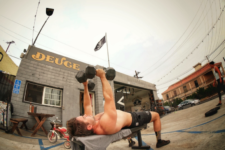
Many days it was par for the course to gulp down eight Advil. That’s not good. In between innings, I could feel a throbbing pain in my shoulder to the rhythm of my heartbeat. While my paycheck was dependant on my throwing arm and it was failing me.
Now, I’m not a doctor, but I do know that any surgeon would have gladly operated on my labrum in the last few years of my baseball career if I let her. Fast forward to a year or so after my baseball career was over. I didn’t opt to have surgery and now I was snatching and pressing barbells overhead for the first time and the pain persisted.
Until it didn’t…
While this isn’t shoulder rehab advice, it’s my experience. Baseball is a conservative, stubborn sport and while I have countless friends who have a handful of surgeries under their belt and still can’t lift their arm to shampoo their own hair, it’s still taboo to strength train the shoulders in the baseball community. There’s a fear in the baseball community that strength training the shoulder, beyond basic banded exercises, is restrictive and even harmful to the goals of a thrower.
As a result, you get high-level baseball athletes who are string most everywhere else but the shoulder. What we know about weak systems is that they are vulnerable. I’d argue that most throwers aren’t strong or stable enough to do their job and, as a result, we have epidemic levels of injury. Is there causation with this correlation between weak shoulders and injured shoulders?
After about a year of dedicated strength training overhead, I’ve gone from Level-10 pain to no pain without surgery or drugs. Maybe this is just my experience, but if you’re interested in getting out of pain or avoiding injury, you might want to consider building a more resilient body for those demands.
How many friends do you have with back pain have strong backs?
Logan Gelbrich
@functionalcoach
8/29/18 WOD
Find a 1RM Strict Press
“11.5”
Then, AMRAP 20
5 Power Cleans (145/100)
10 Toes-to-Bar
15 Wallballs (20/14)

